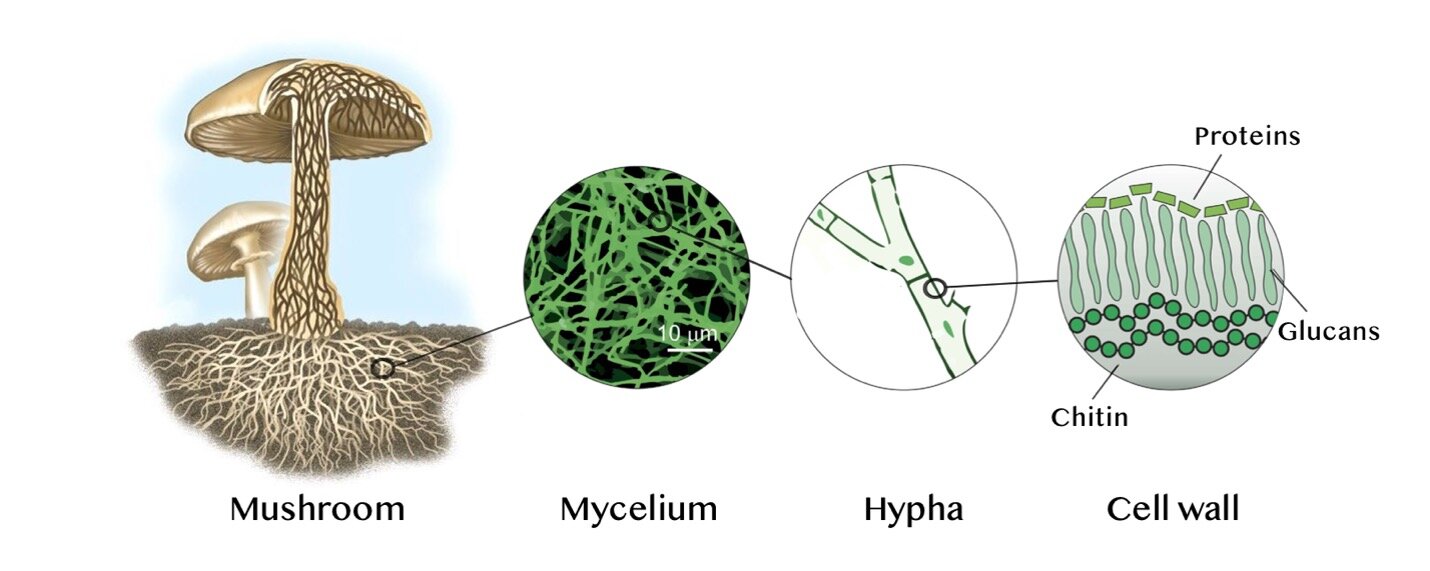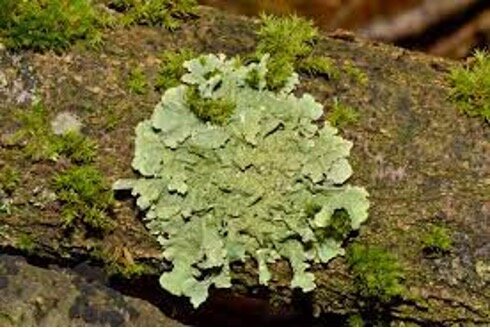Well, this week we won’t be talking about some lost civilization like Atlantis. By “kingdom”, I’m referencing taxonomic kingdoms used to classify all life on Earth. These kingdoms most recently (based on a multinational publication in 2015) include plantae, bacteria, archaea, protozoa, chromista, animalia, and fungi. Kingdom classifications seem to shift over time as we discover new organisms and learn more about life on Earth, but I’m sure most of us remain familiar with the more common ones such as animals (animalia), plants (plantae), and bacteria. And then there’s FUNGI (we’ll ignore archaea, protozoa, and chromista for now). Much more than just mushrooms, the Kingdom Fungi has provided humanity with endless benefits that seem to go unrecognized: beer and wine, medicines, foods such as leavened bread or soy sauce, psychedelic drugs (if you’re into that kind of thing), textiles, and even building materials. The largest organism on Earth is even suspected to be one honey fungus that’s well over 1,000 years old (some suspect 8,650 years old) and living in the Blue Mountains of Oregon. That particular honey fungus spans more than 3 square miles. While we don’t usually think much of the fungi that surround us, maybe it’s time we get to know them better. This week, we’ll take a look at the various types of fungi, how fungi can be cultivated, and the amazing uses of fungi. Don your adventurer outfit and let’s get ready to explore the hidden kingdom of fungi…
An older taxonomic system called the “Whittaker Five-Kingdom” classification of life.
What are the Different Types of Fungi?
The Kingdom Fungi is actually a fairly broad classification and encompasses a wide variety of organisms, from the massive honey fungus to the microscopic single-celled yeast. A few key characteristics of fungi are that they are unable to produce their own food (unlike plants which can), they can reproduce sexually and/or asexually mostly with single-celled spores, and the individual fungi cells have cell walls made of a material called chitin. Chitin is actually the same material that makes up the shells of shrimp, crabs, and some insects! In most cases, the “body” of a fungus is composed of “mycelium”, which is a network of living fibers similar to tightly packed roots of a plant (one exception to this is yeast which remains a single cell). In general, fungi have actually been shown to be more similar to animals than to plants.
Mycelium is a tightly packed network of fibers made of fungal cells. The mycelium basically IS the fungus, similar to how a body with all of its essential organs makes up a human.
Levels of the taxonomic system used to classify all life on Earth
There are a variety of methods that can be used to categorize fungi more specifically, and we’ll cover two of those ways in this article: the common taxonomic phyla within the fungal kingdom …and how a fungus gets its nutrients.
A step down on the scale from Kingdom in the taxonomy world is phylum. There are five main phyla that exist for the Kingdom Fungi (though this is also disputed among scientists), which are identified primarily by how reproduction occurs:
Chytridimycota: This type of fungi includes your old-timers, and some records show that they emerged more than 500 million years ago. Along with being very old, these fungi are predominantly microscopic single-celled organisms and most live in water, though some are multi-celled (but still very tiny). One species is well-known to infect and kill amphibians. These fungi reproduce both sexually and asexually, with their spores being able to swim around using a little flagellum tail.
Zygomycota: BREAD MOLD. Though this group includes plenty of other fungi, the lovely fuzz that grows on your old bread provides a nice example. These fungi will reproduce asexually as a network of mycelium and produce spores that are released from a “sporangium”. When conditions become unfavorable, though, they’ll turn to sexual reproduction by essentially crossing mycelium and sharing DNA with a fungus of a different strain (kind of like male and female), but this process still ends with a “sporangium” that then releases spores.
Bread mold! In the close-up on the right, you can see the little black sporangium ball that forms on the mold, which then releases spores so that more of your bread falls victim.
Here you can clearly see the fruiting body of an ascomycota fungus, but not all fruiting bodies of ascomycota fungus are visible without a microscope.
Ascomycota: This group of fungi includes yeast used in baking and brewing as well as a number of other fungi, including the notorious toxic “black mold” found in some houses. The fungi in this group still reproduce both asexually and sexually, but it happens a bit differently. For ascomycota fungi, asexual reproduction starts as a special protrusion from the fungus that then releases spores. Sexually, two ascomycota fungi of different strains will send out special branches that fuse to form a single “fruiting body”, which may look like a mushroom for some species. This fruiting body forms little sacs filled with spores.
Basidiomycota: This group of fungi includes the classic mushroom that we all know and love… it also includes a fungus that can cause severe respiratory illness. For these fungi, two mycelium of different strains will fuse in sexual reproduction to form a baby mycelium. This baby mycelium will then, under the right environmental conditions, form a fruiting body (mushroom!) that will release spores from little gills underneath the mushroom cap. The spores then act like seeds to form mycelium elsewhere which can fuse with another strain to start the process again.
Perfect real estate opportunity for The Smurfs.
Glomeromycota: This group of fungus is actually a bit special because it isn’t characterized specifically by how it reproduces. Instead, the glomeromycota fungus are characterized by the fact that they pair up with the roots of plants to form a mutually beneficial partnership. The plant provides the fungus with energy in the form of sugars and carbs, and the fungus provides the plant with minerals from the soil. These types of fungi only reproduce asexually and cannot survive without the living plant.
There are a few other forms of fungus that don’t fit nicely into those categories, and there still seems to be some disagreement with how they should be categorized. Outside of these scientific phyla, we can also generally categorize fungi through a different system based on how they get their nutrients:
Saprophytic: Fungi that feed on dead stuff. This includes yeast used to make bread (technically, flour is made of dead plants).
Parasitic: Fungi that get their nutrition from a living organism in a one-way relationship. This includes a variety of human, animal, and plant diseases that are caused by a fungus. One fungus has adapted in an absurd way in which the spores are able to infect an insect and gain control of the insect’s movements in order to make it travel to an optimal location for growth. The fungus then kills and eats the insect and grows out of its body. That’s wild…check it out here:
Mycorrhizal and Symbiotic: Fungi that live with another living organism in a mutually beneficial relationship. An example is lichen, which is actually composed of multiple organisms including more than one type of fungi! Within lichen, the fungi provide structure and protection for algae which in turn produce sugars for energy.
Lichen on a tree is actually multiple organisms coexisting
Cultivation
While growing your own house plant seems pretty common, growing your own fungus (intentionally, at least) might be less so. Most species of fungus that we prefer to grow as humans seem to be saprophytic, which I would say makes sense since mycorrhizal/symbiotic fungi requires managing multiple living organisms… and nobody likes parasitic fungus. Within the group of saprophytic fungus, we as humans tend to focus on intentionally cultivating various mushrooms and yeast.
Commercial production of mushrooms is actually a very large business, raking in just over 38 billion US dollars in 2017 across the entire globe. Mushrooms themselves are nutritious and provide vitamins and minerals such as selenium, zinc, potassium, and a suite of B vitamins while also being extremely low in fat and cholesterol. The most prominent species of mushrooms that are cultivated (and remember, the mushroom is only one part of the actual fungus) include button, shiitake, and oyster mushrooms. One thing to note is that baby bella, cremini, white, and portabella mushrooms are all the same type of mushroom (the button mushroom!) cultivated at different ages of development.
Mushrooms have been used more and more in foods as vegetarian alternatives become more salient at the supermarket and in restaurants. You can also take a look at this video from Gordon Ramsay about using mushrooms in cooking:
So… how are they grown on a large scale? Well, the saprophytic fungi that we eat require a few key ingredients including moisture, some “dead organic stuff” to serve as their food and growing medium, and oxygen. The “dead organic stuff” can be anything from wood chips to coffee grounds to corn husks, and this dead stuff is usually sterilized prior to starting the mushrooms in order to remove potential diseases or competing fungi. Once you have moist, aerated dead stuff, spores are added. The spores grow to form mycelium which then sprouts a bunch of mushrooms. This commercial production of mushrooms is typically done indoors since fungi can be a bit finicky in terms of the environmental conditions that encourage mushrooms to sprout. Temperature, humidity, air flow, and the level of light are all tightly controlled in accordance with the species of mushroom being grown.
Growing your own mushrooms at home is actually not too difficult, either! You can even use wetted cardboard to serve as the food source for the mushrooms, and instead of starting from spores, you can cut up store-bought mushrooms (which are alive) to get started. Here’s one of many quick how-to videos available online:
Humans also cultivate yeast fungus (specifically the species Saccharomyces cerevisiae in most instances) in order to make a variety of consumable creations including beer, wine, and leavened bread. Special strains of yeast are also used to make the ethanol that is used in gasoline fuel for cars (note the “10% ethanol” label on some gas pumps). Yeast primarily only needs water, oxygen, and a food source in order to grow. As a saprophytic fungus, this food source is usually dead plants of some form (wheat in the case of bread flour, and grapes in the case of wine). In commercial production of yeast, the dead plant is replaced with pure molasses or sugar (still derived from a plant) and a handful of other essential nutrients that the yeast needs to multiply and grow.
Instead of growing from spores like in mushroom production, yeast producers start from other yeast cells that have been stored in a “yeast strain bank”. The yeast strain bank is an extremely cold freezer that keeps specific strains of yeast alive while preventing them from multiplying or getting infected. Different strains of yeast are suited to different environments or applications. For example, you COULD use baking yeast to make wine or beer, but the final product would not taste very good since the baking yeast would probably die at a lower alcohol content and create off-flavors as it struggles to eat something besides wheat flour. A nice summary of the process of yeast production is given by Lesaffre (who I am not explicitly endorsing) here:
You can also certainly cultivate your own yeast at home by using the natural omnipresence of yeast cells. You basically create optimal growing conditions for the yeast which can be something as simple as some food source (flour or another dead plant) soaked or saturated in water. In this case, it’s a bit more difficult to harness the natural yeast since they have to compete with all of the other natural bacteria and other organisms, but it’s still the same concept of growing the little fungus cells. Harnessing natural yeast is done for more than just sourdough bread and is used to make sour beers or wines… or even some apple juice that turns into hard cider after you let it sit out a bit too long.
Nifty Uses for Fungi
Eating mushrooms and making bread or alcohol is certainly appealing, but humans have also found uses for fungi in some strange places due to the organism’s unique characteristics.
Fungi are experts at metabolizing and breaking down dead stuff, which is convenient if you have a compost pile or a dead body you’re trying to get rid of (there’s actually a fungi burial suit that speeds up decomposition of your dead body: https://coeio.com/). But fungi are ALSO versatile enough to metabolize and break down toxic substances in what is called mycoremediation, which is pretty spectacular. Past mycoremediation projects have used various fungi to remove or capture heavy metals (such as arsenic), pesticides, herbicides, oil spills, and toxic PCBs among other substances from contaminated soil or water.
An image of the mold fungus that naturally produces penicillin, an antibiotic
Fungi have also been invaluable in the development and production of medicines. The antibiotic Penicillin was derived from a mold back in 1928 and revolutionized medicine at the time. Today, bacterial resistance has made penicillin less effective… BUT there are still plenty of other ways that fungi have helped in the discovery of new medicines. The chemical Lovastatin was also isolated from a mold fungus back in 1978. Lovastatin is used as a medication to lower LDL cholesterol, which can reduce the risk of heart disease. Cyclosporine is another fungus-derived medication, and it is used as an immunosuppressant to treat autoimmune disorders and to help in acceptance of a new organ after organ transplant.
This building, although more of an art installation, is made from bricks that are composed of chitin material, which was grown from fungal mycelium
Perhaps even more bizarre is the use of fungus to create everyday materials. If you recall, the chitin that makes up the cell wall of most fungi is also the same material that forms the shells of shrimp and crabs, which can be fairly sturdy. Chitin is also effective as a flame retardant while still remaining 100% compostable. Companies have begun using fungi to grow chitin-based things such as furniture, packaging materials, and even structural bricks and wall panels. While wood from trees is also a useful building material, fungus grows at a much more rapid rate. The rapid growth of fungi along with its structural abilities and versatility also make it a potential option for constructing shelters in disaster relief areas or resource-deprived regions.
Aaaaaand we’re back to foods. Besides directly eating mushrooms or using yeast to bake bread or ferment beer and wine, fungi are present in other foods that we eat. One species of fungus is needed in the fermentation of soy sauce as well as miso and sake. Soy sauce is made when soybeans are mixed with wheat flour into a cake form that is then inoculated with the fungus called Aspergillus oryzae. The fungus covers the soy cake, which is then further fermented with a special type of bacteria in salty water before being filtered into traditional soy sauce. In many cases, you’ve probably instead used the “non-brewed” soy sauce which uses a quick acid process and a bunch of additives in place of the slower fungus-based process. Fungus is also present in several cheeses in the form of mold, such as in bleu cheese or in Brie.
While fungi are pretty useful in food production, it’s also important to be wary of extremely poisonous mushrooms. Some of these poisonous mushrooms even resemble common edible ones, which is quite unfortunate. Thankfully the names of some of the more toxic species make it obvious that they’ll most likely end up poisoning you, including the names Death Caps, Destroying Angels, and Deadly Dapperlings. The Destroying Angel mushrooms are considered to be one of the most toxic in North America and can cause vomiting, convulsions, and liver and kidney failure with symptoms starting within 24 hours of ingestion.
An image of the Destroying Angel mushroom
Though our adventure into the Hidden Kingdom of fungi is now coming to a close, you don’t have to look far in order to continue your exploration. The wild world of fungi surrounds you everyday whether you sip on some wine, cook up some oyster mushrooms, take Lovastatin medication, deal with a fungal infection, or have bread that’s being consumed by mold AGAIN.
To think about…
What kinds of fungus do you observe or come into contact with throughout the day?
Which do you think is easiest to produce for eating as food: edible fungi, plants such as fruits and vegetables, or animal products such as meat and dairy? Why?
Of the uses mentioned in this article (mycoremediation, medicine, food, building material, etc.), which do you think is the most promising for future development? Do you know of any other uses for fungi, or do you have any ideas for potential uses?
Sources
https://www.forbes.com/sites/linhanhcat/2019/02/22/largest-organism-in-the-world/?sh=73c7f7bc44ac
https://www.britannica.com/science/taxonomy/Current-systems-of-classification
https://doi.org/10.1371/journal.pone.0119248
https://www.thoughtco.com/types-of-fungi-4132341
https://medium.com/@stonev/when-mushrooms-go-in-the-lab-growing-design-882bff633aa8
http://pressbooks-dev.oer.hawaii.edu/biology/chapter/classifications-of-fungi/
https://byjus.com/biology/kingdom-fungi/
https://namyco.org/education.php
https://herbarium.usu.edu/fun-with-fungi/what-are-fungi
https://owlcation.com/stem/Medications-From-Molds-Fungi-and-Health
https://thecounter.org/mycoremediation-radical-mycology-mushroom-natural-disaster-pollution-clean-up
https://smallfarms.cornell.edu/projects/mushrooms/mycology-101/
https://apnews.com/press-release/pr-wiredrelease/d3d5794b89331f97c478c58238501ba7
http://www.botany.hawaii.edu/faculty/wong/BOT135/Lect16.htm
https://www.britannica.com/list/7-of-the-worlds-most-poisonous-mushrooms











